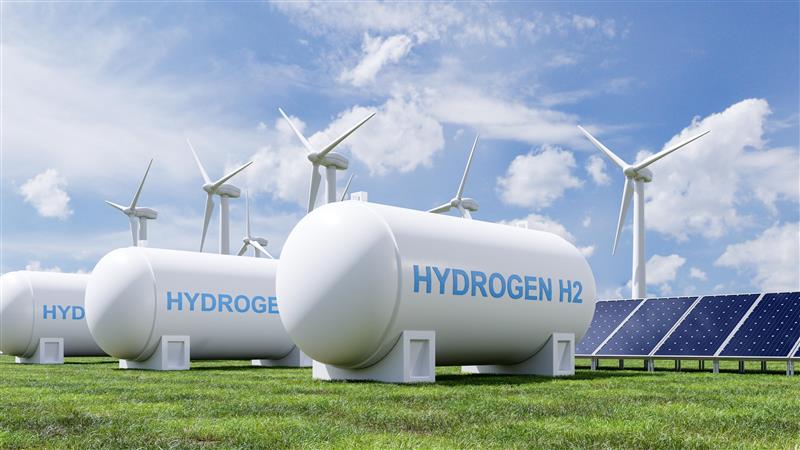 Hydrogen storage system rendering, courtesy of vanitjan/Shutterstock.com.
Hydrogen storage system rendering, courtesy of vanitjan/Shutterstock.com.
Building a Healthy Hydrogen Economy This Earth Day
Each year, Earth Day serves as a reminder of the importance of investing in the planet for a cleaner, healthier future. U.S. investments are moving forward at a rapid pace, specifically with a growing focus on the critical role of clean energy technologies like hydrogen. This Earth Day is an opportunity to celebrate the Earth alongside the growth and contributions from the hydrogen industry to power and protect our planet.
With the Bipartisan Infrastructure Law’s (BIL) Regional Clean Hydrogen Hubs program building nationwide support for clean hydrogen infrastructure, and the Inflation Reduction Act’s (IRA) Clean Hydrogen Production Tax Credit and other financial incentives promoting hydrogen production and use, the U.S. is passing major milestones toward building a national hydrogen economy.
Investing in the Planet is Investing in Hydrogen
The International Energy Agency (IEA) projects that global hydrogen production will need to almost double by 2030 in order to reach a net-zero scenario, and the U.S. Department of Energy (DOE) estimates that the U.S. will need to grow domestic production by 10 million metric tonnes (MMT) per year by 2030 to reach national climate goals, with the number growing each of the following decades. To reach those goals, the U.S. will need to deploy comprehensive infrastructure to ensure hydrogen is available at the right place and time and in the correct quantities to meet demand.
While the DOE National Clean Hydrogen Strategy and Roadmap is still being developed, the draft released in September 2022 outlines strategies to grow and enable the environmental benefits of clean hydrogen, including targeting strategic, high-impact uses like industrial, transportation, and power sector applications that are energy-intensive and can’t be decarbonized through other pathways like electrification. The Roadmap also includes a focus on regional networks, building off of the Clean Hydrogen Hub projects to create nationally connected infrastructure and accelerate demand-side industry growth. The final Roadmap will provide a framework for industry growth in the coming years, enabling zero-emitting technologies to reach across the United States and bring climate benefits to all – provided policy offers clear, workable standards for industry.
Growing the Clean Hydrogen Industry
The BIL’s Regional Clean Hydrogen Hubs Program is working to build hydrogen infrastructure by investing $8 billion into at least four large-scale hydrogen production and utilization projects across the country. Thirty-three entities ranging from Hawai’i to Florida were encouraged to submit final applications to the initial $7 billion funding opportunity, and final applications propose projects reaching across both coasts. Hub awardees are expected to be announced in the fall of 2023, with initial funding kicking in by the end of 2023. These projects promise long-term investments in clean energy systems that will lower carbon emissions across the United States.
The IRA, on the other hand, aims to boost infrastructure investments through tax credits supporting the production and usage of clean hydrogen, clean vehicles, and associated components and technologies. As the Internal Revenue Service (IRS) is developing final guidance for the highly anticipated Clean Hydrogen Production Tax Credit, the agency is working with the Department of Energy to ensure the credit enables the core goal of the program—promoting the generation of clean hydrogen for use in decarbonizing critical sectors. To do so, it’s critical for implementation rules to be simple, practical, and workable to grow U.S. hydrogen production capacity to the scale needed to reach emissions reduction goals.
Pathways to a Clean Hydrogen Ecosystem
These investments in hydrogen are a down payment on a cleaner energy system and a cleaner earth. With the ability to decarbonize transportation, heating, and manufacturing, as well as support a more resilient grid, hydrogen has an important role to play in helping us reach our national and global net-zero goals. Looking forward, industry and government should work to continue these investments in practical decarbonization solutions that enable large-scale emissions reductions. We know much work and many challenges lie ahead, but we are committed to working toward a bright future and a more sustainable world.
This Article is Supported by Hydrogen Forward—A Partner of World War Zero
Hydrogen Forward is a coalition of companies across the value chain that are working to ensure hydrogen is a key contributing solution in the energy transition. The coalition works in concert with allies across industries and sectors to educate decision-makers and stakeholders on the value hydrogen delivers today and the important role that it should play in our future.





